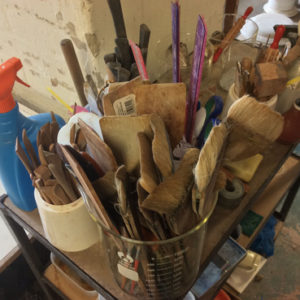Summary:
Shortly before the end of the project, the results already obtained as well as the interim results of the public have been presented and discussed. In addition, the latest developments from industry and research have been shown. The meeting took place during the British Ceramics Biennial in 2017 in order to reach the largest public possible.
Responsible:
Ulster University/Belfast Campus
British Ceramics Biennial (BCB) team, Stoke-on-Trent
The Potteries Museum & Art Gallery, Stoke-on-Trent
Duration:
1st September 2016 – 31th October 2017
Place/ Date:
Stoke-on-Trent, The Potteries Museum & Art Gallery/British Ceramics Biennial, Spode factory side, 5 – 6 October 2017
Congress “CERAMIC VALUES: Can Ceramics make a difference?”

The Congress (5-6 October 2017) „CERAMIC VALUES: Can Ceramics make a difference?”, marked the culmination of the Ceramics and its Dimensions project. Led by Ulster University, in association with the Potteries Museum and Art Gallery (PMAG), Stoke City Council, Staffordshire University and the British Ceramics Biennial (BCB), it aimed to contribute to the debate about the value and role of ceramics in contemporary society. Held to coincide with the 5th British Ceramics Biennial in Stoke-on-Trent, sessions were organised at both PMAG and the BCB’s former Spode factory site.
A central goal of the Congress was to disseminate the main findings of the ten modules of the Ceramics and its Dimensions project, relating these to the wider European and international ceramics context. To this end, a Round Table discussion allowed each module leader to present the salient points of their research to the delegates. A series of sessions at PMAG focussed on a range of topics derived from the initial call for papers, including: ceramics and education; tradition and heritage; analogue and digital craft; place and materiality; wellbeing and museum engagement; museum collections and object biographies. A further session presented by recipients of the Future Lights prize discussed the challenges of building a career in ceramics, while Module 4 was represented by a ‘prop ceramics’ interactive screen (see Module 4). The PMAG sessions were complemented by the parallel programme at the BCB’s Spode site, which included a range of displays and workshops, notably the Shaping the Future touring exhibition (see Module 6) and the participatory Clay Playground (see Module 7).
The Congress was headed by an eminent group of keynote speakers, who responded to the Congress themes of skills, value and place. Claudia Casali, Director of the International Museum of Ceramics in Faenza, opened the Congress by outlining the history of ceramics and identifying key trends in contemporary ceramic practice. Ceramicist Neil Brownsword discussed the importance of skills transference and highlighted the threat to intangible cultural heritage by reference to his Factory exhibition at the BCB. Artist Keith Harrison discussed performative ceramics and entertained the audience with accounts of flying cars made from clay and other examples of ceramics in the public realm. Franz Chen, founder and CEO of Jingdezhen-based Franz Porcelain, shared his experience of establishing an international ceramics business, while also chairing the Future Lights session on building a career in ceramics. Jay Thakkar discussed his socially engaged work with warli folk craftspeople in India, referring to the Heart:Beat Project at the BCB. Finally, historian and theorist Laura Breen warned against the dangers of self-ghettoization in ceramics, arguing for interdisciplinarity.
There were 46 presenters and exhibitors, not including the partner Round Table, and contributions were made by 28 representatives of the Ceramics and its Dimensions partners. Delegates and speakers travelled from as far away as India, Taiwan, China, South Korea and Japan, as well as from all across Europe. Attracting over 320 delegates over two days, including ceramic sector specialists, museum professionals, academics, and large student groups from the UK and Ireland, feedback suggests that the Congress succeeded in stimulating a relevant and lively debate about the current state and future of ceramics in Europe and the rest of the world.
